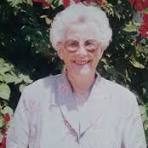Nora Veronica O’Brien was born in Ballinderry near Tuam, County Galway Ireland on August 17, 1923, second of eight children. Nora had three sisters and four brothers.
Nora received her early education at the Mercy convent school in Tuam.
In February of 1943, Nora joined the convent of the Missionary Sisters of the Holy Rosary in Killeshandra, County Cavan, as a postulant. At her profession in August of 1945, she became known as Sister Mary Lucy.
After her profession, Sister Lucy went to Dublin to study medicine at the University College and became a physician in 1952.
In 1953, Sister Lucy was assigned to the west African nation of Nigeria. For the next fourteen years, Sister Lucy worked as a sister-physician in various mission hospitals. She not only did clinical medicine and hospital administration, but she also took time to expand her medical knowledge. For example, in 1959, she received a diploma in tropical medicine and hygiene.
In 1964, Sister Lucy, with other colleagues, opened St. Charles Borromeo Hospital in Onitsha, Nigeria and became the medical superintendent there.
Unfortunately, from 1967-1970, a region of Nigeria that called itself the Republic of Biafra, entered a war with Nigeria. Because Onitsha was considered the capital of Biafra, it was continually being bombed. The hospital became overwhelmed with refugees and casualties from both sides of the war. The war, along with a famine, led Biafra to become famous throughout the world as a symbol for the ravishes of war and poverty. It was common to see posters showing children of the area looking like skeletons because of malnutrition.
Because of the war, Sister Lucy and other non-Nigerian workers had to leave the country.
After leaving Nigeria, Sister Lucy took this opportunity to go to London to get further education in gynecology. In 1971, she became a member of the Royal College of Obstetricians and Gynecologists.
From London, Sister Lucy returned to west Africa again, this time to Sierra Leone in 1976. There, she served for the next four years.
In Sierra Leone, she worked at Monze Mission Hospital, later named Monze District Hospital. In addition to her clinical practice, Sister Lucy taught hundreds of other physicians. Sister Lucy also brought national fame to the Monze hospital by becoming a center for repairing fistulas.
Following her work in Sierra Leone, Sister Lucy worked in Zambia, a nation in south-central Africa. There, she became famous for her work with AIDS patients and for sharing her expertise with others. For example, Sister Lucy was on many national committees such as the national AIDS advisory committee.
One of Sister Lucy’s many gifts included that of attracting others to support her work financially. Not only did family and friends support her work, but various groups, such as Rotary, also helped. Sister Lucy officially retired in 1999.
In 1998, the Royal College of Physicians of Ireland made her an honorary member, and in 2004, Zambian President Levy Mwanawasa awarded her the Order of Distinguished Service, First Division, because of her service to the women of Zambia.
Sister Lucy died in Lusaka, capital of Zambia, on April 10, 2006.
At her funeral Mass, flags of four nations were carried in the offertory procession to represent the four nations served by Sister Lucy: Ireland, Nigeria, Sierra Leone, and Zambia.



